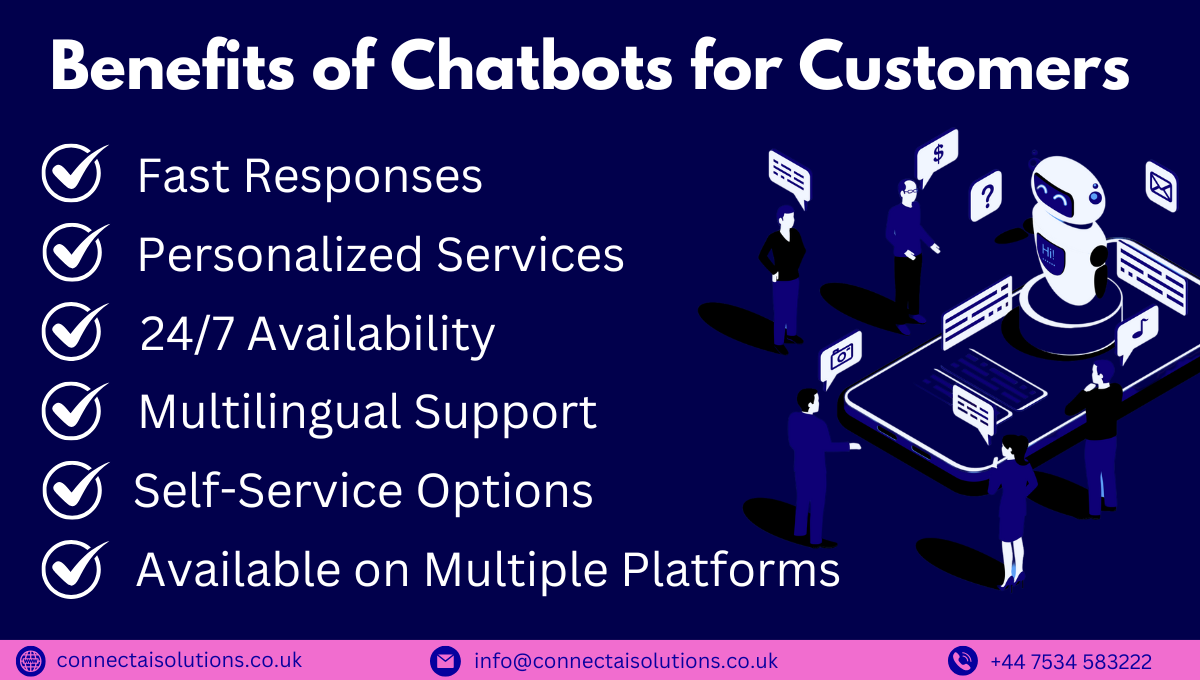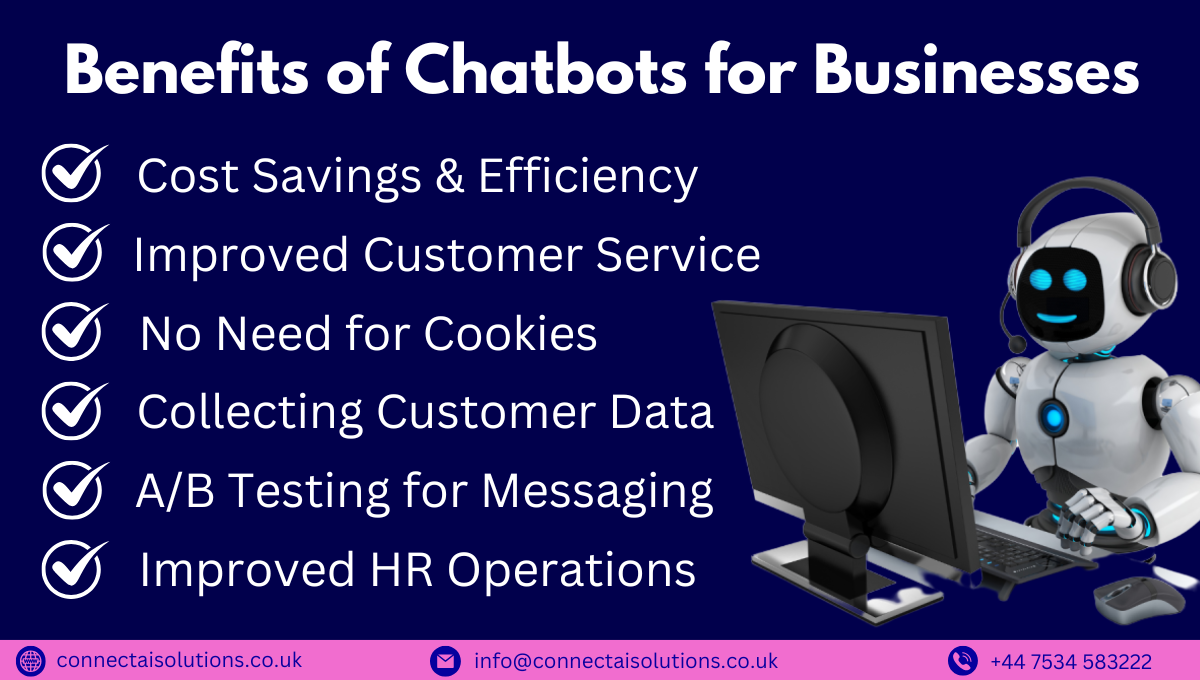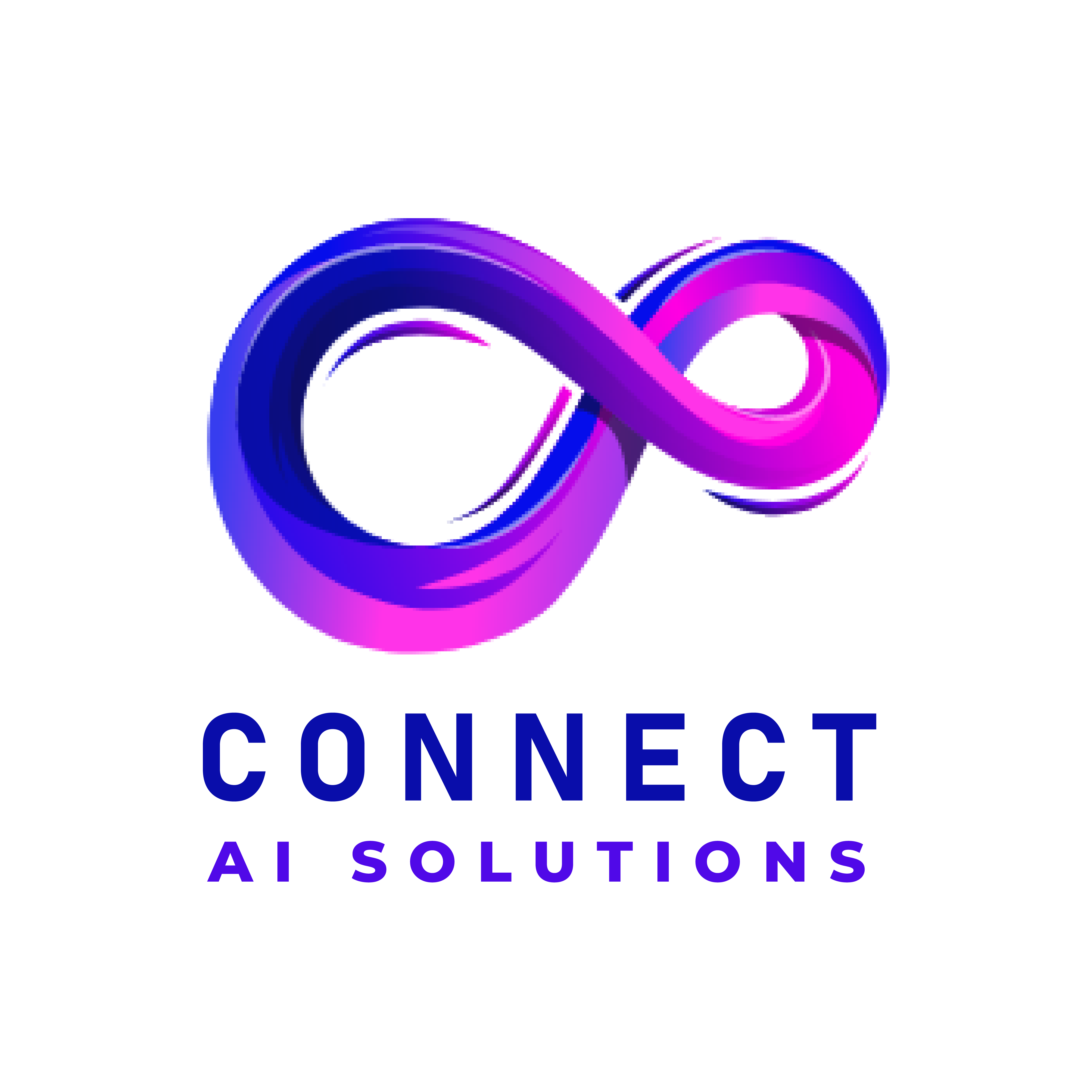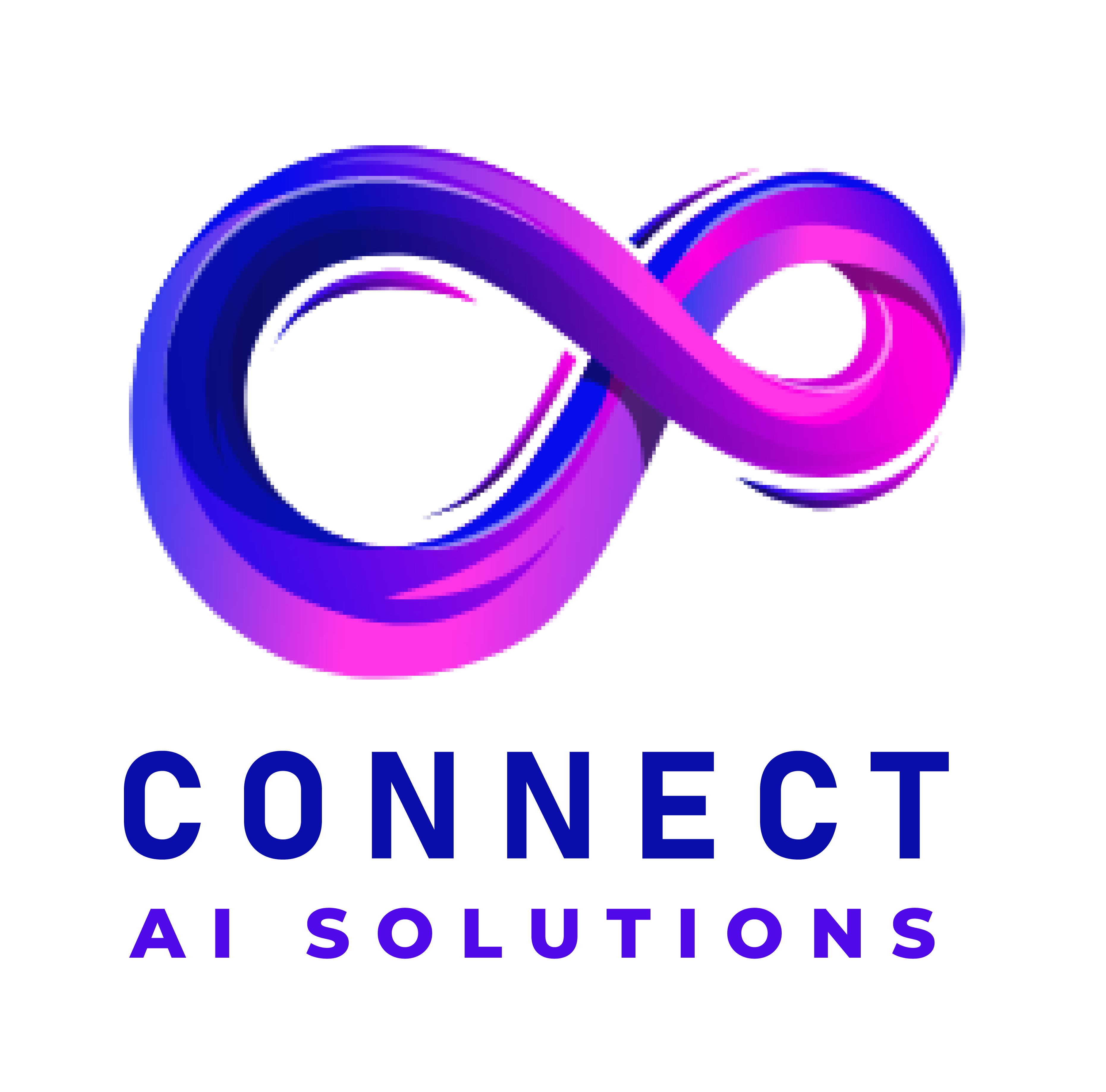The Benefits of Chatbots for Businesses and Customers

This article will show you the benefits of chatbots for businesses and customers. Let us come and learn about them in complete detail. AI chatbots respond to queries using text, voice, or both to help customers and businesses quickly and effectively. They eliminate the need for human intervention and manual research, making customer interactions smoother and faster. Chatbots are now used everywhere, like smart speakers, and messaging apps like WhatsApp, Facebook Messenger, Slack, and SMS.
The Benefits of Chatbots for Businesses and Customers
Modern AI chatbots (virtual assistants) use advanced technology to understand conversations and automate tasks. They make customer service easier and eliminate old-fashioned phone menu prompts like, “Press 6 to speak to an agent.” Here are the benefits of the chatbots for Businesses and Customers. So let us discuss it.
Benefits of Chatbots for Customers
Here are the benefits of chatbots for customers, delve into the information and get the best opportunity to learn about AI from Connect AI Solutions.
1. Fast Responses
Fast response is one of the most demanding benefits of chatbots. Chatbots provide instant answers 24/7, ensuring customers get the help they need immediately. Customers don’t like waiting. They handle multiple queries at once, eliminating long wait times and improving customer satisfaction. By using this AI-powered automation, businesses can reduce response times and enhance the overall user experience.
2. Personalized Services
AI chatbots analyze customer interactions to provide recommendations and suggest relevant products, increasing satisfaction and engagement. They track purchase history, preferences, and browsing behavior to deliver targeted promotions and customized solutions, making the customer feel valued and understood.
3. Available on Multiple Platforms
Chatbots work on websites, mobile apps, social media, SMS, and messaging apps. These chats are allowing businesses to engage with customers wherever they are. This omnichannel support ensures seamless communication and brand consistency across different digital touchpoints, improving accessibility for customers.
4. Multilingual Support

AI chatbots can detect languages automatically and provide appropriate responses. Customers can interact in their preferred language. This feature helps businesses expand their global reach and cater to diverse audiences. It does not require additional human support, improving inclusivity and customer satisfaction.
5. Self-Service Options
Many customers prefer solving simple problems themselves. Chatbots provide step-by-step guidance. It saves time for both customers and businesses. They offer troubleshooting solutions, FAQs, and automated processes. The tasks they include are booking appointments, tracking orders, and resetting passwords, reducing reliance on human agents.
6. 24/7 Availability
Chatbots work around the clock, assisting even outside business hours. This ensures customers receive support anytime they need it, leading to better engagement and retention. Businesses can save costs by reducing the need for large support teams while maintaining high service quality.
7. No Repetitive Information
Chatbots store customer interactions, so customers don’t have to repeat the same information when transferred to a human agent. This creates a smoother experience, reduces frustration, and speeds up issue resolution. By maintaining customer history, chatbots help businesses build stronger relationships and improve service consistency.
Benefits of Chatbots for Businesses
Here are the benefits of Chatbots for Businesses:
1. Better Customer Engagement & Loyalty
Chatbots automate customer support, reducing wait times and improving user experience. They free employees from repetitive tasks, allowing them to focus on complex issues.
2. Cost Savings & Efficiency
Chatbots reduce staffing costs by handling common queries. These chatbots are allowing businesses to optimize their workforce.
3. Improved Customer Service
Chatbots answer repetitive questions, letting human agents focus on solving complex problems.
4. Increased Sales & Lead Generation
AI-powered chatbots guide customers through the buying process. They provide product recommendations and assist with conversions.

5. Handling High Volumes of Customers
Unlike human agents, chatbots can handle multiple conversations at the same time, making them highly scalable.
6. Collecting Customer Data
Chatbots capture customer details during interactions. Chatbots are helping businesses build marketing lists and personalize outreach efforts.
7. No Need for Cookies
AI chatbots collect valuable customer insights without using cookies, ensuring compliance with privacy regulations.
8. Lead Nurturing
Chatbots follow up with potential customers, sending reminders and promotional messages to guide them through the sales funnel.
9. A/B Testing for Messaging
Businesses can test different chatbot responses to see which messages engage customers the most.
10. Improved HR Operations
Chatbots assist HR teams by answering employee FAQs, processing leave requests, and helping with onboarding.
11. Consistent Communication
Chatbots provide uniform responses, ensuring customers get the same information every time, improving brand integrity.
12. Staying Calm Under Pressure
Unlike human agents, chatbots never lose patience, helping defuse frustrated customer interactions before transferring them to a human.
Industry-Specific Benefits of chatbots:
Here are the industry-specific benefits of chatbots:
1. Banking & Finance
Chatbots answer customer queries, provide account information, and assist with transactions quickly and efficiently.
2. E-commerce & Online Marketing
Chatbots recommend products, answer common shopping queries, and provide seamless customer support.
3. Government Services
Chatbots help citizens access information on bills, events, and services, improving efficiency and reducing costs.
4. Healthcare
Chatbots assist with appointment scheduling, prescription refills, and medication reminders, enhancing patient experience.
5. HR & Employee Support
AI-powered chatbots help employees with common HR queries, such as leave requests and onboarding.
6. Insurance
Customers can get instant quotes, file claims, and make payments using chatbots, streamlining the insurance process.
7. Real Estate
Chatbots help answer property-related queries, collect customer preferences, and schedule property viewings.
Key Considerations When Using AI Chatbots

1. Chatbots Are Not Humans
- Limited Understanding: While AI chatbots can process natural language. They may misinterpret complex queries or lack the emotional intelligence of human agents.
- Personality & Context Awareness: Businesses can program chatbots with a friendly personality and context-aware. It responds to make interactions feel more natural.
- Seamless Handover to Humans: When chatbots cannot resolve an issue, they should seamlessly transfer the customer to a live agent, ensuring a smooth support experience.
- Continuous Learning: AI-powered chatbots improve over time by learning from interactions. However, they still require regular updates to stay accurate and effective.
2. Implementation Takes Time
- Training & Optimization: The initial setup involves feeding the chatbot relevant data, training it on different scenarios, and optimizing responses for accuracy.
- Integration with Business Tools: Businesses must integrate chatbots with CRM systems, databases, and communication channels to enhance functionality.
- Testing & Refinement: Before full deployment, businesses should run tests to identify gaps and refine chatbot behavior to ensure a seamless customer experience.
- User Education: Customers and employees need time to adapt to chatbot interactions. Providing clear instructions and onboarding support can improve adoption rates.
3. Regular Maintenance Is Needed
- Updating the Knowledge Base: As customer needs evolve, chatbots must be regularly updated with new product details, FAQs, and business policies.
- Analyzing Customer Interactions: Reviewing chatbot interactions helps businesses identify common customer pain points and improve chatbot responses accordingly.
- Performance Monitoring: Businesses should track chatbot performance metrics, such as response time, resolution rate, and customer satisfaction, to make necessary improvements.
- Enhancing AI Capabilities: AI chatbots can be enhanced with machine learning algorithms to better understand user intent and provide more relevant responses over time.
Best Practices for E-commerce Chatbots
1. Be Transparent
Customers should always be aware that they are interacting with a chatbot rather than a human agent. Transparency builds trust and helps set realistic expectations for the conversation. Businesses should introduce the chatbot clearly at the beginning of the interaction and, if possible.
It provides the option to connect with a human agent when needed. Additionally, chatbots should be designed to communicate in a friendly yet professional manner, ensuring users feel comfortable while engaging with them.
2. Protect Customer Privacy
Data security is a top priority when using chatbots. Businesses must ensure that chatbots collect only essential customer information and adhere to data protection regulations, such as GDPR or CCPA.
Sensitive information, such as payment details or personal identification numbers, should never be stored or requested unless encrypted and handled securely. Providing clear privacy policies and informing customers about how their data will be used can further strengthen trust in chatbot interactions.
3. Use AI for Accuracy
A well-trained chatbot should provide precise and up-to-date answers to customer queries. Businesses should continuously update chatbots with relevant information, including product details, company policies, and FAQs, to improve accuracy.
Additionally, AI-powered chatbots should be programmed to detect and acknowledge changes in customer transactions, such as order modifications or refunds, and notify customers accordingly. If a chatbot is unsure about an answer, it should admit its limitations rather than provide misleading or incorrect information.
4. Prioritize Speed & Responsiveness
One of the main advantages of chatbots is their ability to deliver instant responses. Businesses should ensure that chatbots are optimized for speed and provide relevant, concise, and helpful replies.
A slow or unresponsive chatbot can frustrate customers and negatively impact their experience. Using AI to analyze past interactions can help chatbots anticipate customer needs and offer proactive assistance, reducing waiting times and improving engagement.
5. Know When to Transfer to a Human Agent
While chatbots are great for handling common queries, they should recognize when an issue is too complex and requires human intervention. A well-designed chatbot should seamlessly escalate the conversation to a human agent without requiring the customer to repeat their details.
Additionally, providing estimated wait times and offering callback options can enhance customer satisfaction. Ensuring a smooth transition between chatbot and human agents improves the overall customer service experience and prevents frustration.
Challenges of AI Chatbots
They offer many benefits of chatbots, but they also have some drawbacks.
- Too Many Pre-Chat Questions: Customers may get frustrated answering multiple questions before speaking to a human agent.
- Occasionally Limited Understanding: Chatbots might not always understand complex or unique queries.
- Need for Continuous Improvement: AI chatbots learn from interactions, meaning businesses must regularly update their chatbot’s responses.
The Solution:
- Chatbots handle FAQs and deflect unnecessary tickets.
- Chatbots filter and organize queries before sending them to human agents, reducing manual work.
- Chatbots collect customer data, making human interactions faster and more efficient.
With continuous learning and updates, chatbots improve, ensuring better service and customer satisfaction.
Conclusion:
This article has explained to you the benefits of chatbots. These AI chatbots are transforming customer service and business operations. When implemented correctly, they enhance customer experiences, increase efficiency, and boost sales. While they require setup, maintenance, and occasional human intervention, their benefits far outweigh their challenges, making them a valuable asset for any business.
Must Read: Artificial Intelligence Consulting Services





